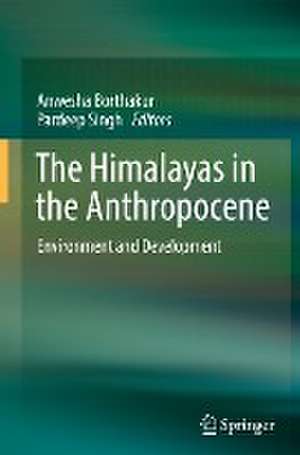The Himalayas in the Anthropocene: Environment and Development
Editat de Anwesha Borthakur, Pardeep Singhen Limba Engleză Hardback – 17 feb 2024
Preț: 732.84 lei
Preț vechi: 893.71 lei
-18% Nou
Puncte Express: 1099
Preț estimativ în valută:
140.24€ • 152.29$ • 117.81£
140.24€ • 152.29$ • 117.81£
Carte tipărită la comandă
Livrare economică 22 aprilie-06 mai
Preluare comenzi: 021 569.72.76
Specificații
ISBN-13: 9783031501005
ISBN-10: 3031501004
Pagini: 291
Ilustrații: VII, 291 p. 44 illus., 42 illus. in color.
Dimensiuni: 155 x 235 mm
Greutate: 0.59 kg
Ediția:1st ed. 2024
Editura: Springer Nature Switzerland
Colecția Springer
Locul publicării:Cham, Switzerland
ISBN-10: 3031501004
Pagini: 291
Ilustrații: VII, 291 p. 44 illus., 42 illus. in color.
Dimensiuni: 155 x 235 mm
Greutate: 0.59 kg
Ediția:1st ed. 2024
Editura: Springer Nature Switzerland
Colecția Springer
Locul publicării:Cham, Switzerland
Cuprins
Preface.- Foreword.- Himalayas in the Anthropocene: An overview.- Anthropogenic environmental burdens in the Himalayas.- Haphazard urbanization and the Himalayan towns.- Unorganized tourism practices and the allied challenges in the Himalayas.- Big dams in the Himalayan mountain ecosystem.- Deforestation and landslides by anthropogenic activities in the Himalayas.- Mining and quarrying activities in the Himalayas.- Climate change implications in the Himalayas.- Disaster preparedness and awareness in the Himalayas.- Water and soil degradation in the Himalayan mountain ecosystem.- Anthropogenic impacts in the Himalayas and the Sustainable Development Goals (SDGs).- Environment or Development: The way forward.
Notă biografică
Dr. Anwesha Borthakur is presently a Landhaus Fellow at the Rachel Carson Center for Environment and Society, Ludwig Maximilian University of Munich in Germany. She is an affiliate with the University of Leuven (KU Leuven) in Belgium from where she completed her Marie Skłodowska-Curie Postdoctoral Fellowship in 2021. Prior to that, she obtained her PhD in science policy from Jawaharlal Nehru University (JNU), New Delhi, India. She has published over 40 research articles/book chapters in peer-reviewed, indexed journals/books and edited volumes on topics associated with environmental sustainability. Her broad areas of research interest include waste governance, electronic and textile waste, traditional ecological knowledge, public engagement for environmental sustainability and scientometric analysis.
Dr. Pardeep Singh is presently an Assistant Professor at the Department of Environmental Studies, PGDAV College, University of Delhi in New Delhi, India. He obtained his PhD fromthe Indian Institute of Technology (Banaras Hindu University), Varanasi. He was selected as a Young Scientist by the Department of Science and Technology (DST), India for the BRICS Young Scientist Conclave held in Durban, South Africa. His research interests include waste management, wastewater treatment, water scarcity and global climate change. He has published more than 75 research papers/book chapters in international journals/books in the field of environmental science. He has also edited more than 40 books with various international publishers including Springer Nature, Elsevier, CRC Press and Wiley.
Dr. Pardeep Singh is presently an Assistant Professor at the Department of Environmental Studies, PGDAV College, University of Delhi in New Delhi, India. He obtained his PhD fromthe Indian Institute of Technology (Banaras Hindu University), Varanasi. He was selected as a Young Scientist by the Department of Science and Technology (DST), India for the BRICS Young Scientist Conclave held in Durban, South Africa. His research interests include waste management, wastewater treatment, water scarcity and global climate change. He has published more than 75 research papers/book chapters in international journals/books in the field of environmental science. He has also edited more than 40 books with various international publishers including Springer Nature, Elsevier, CRC Press and Wiley.
Textul de pe ultima copertă
This book aims to provide a comprehensive overview of the current challenges in one of the most biodiverse regions in the world. Environmental sustainability and climate change implications in the mountain ecosystems in general and mountainous regions of the Global South in particular are key concerns of the present-day world. In particular, the mountainous regions in the Global South are excessively being subjected to haphazard developmental activities making them vulnerable to all possible aspects of climate change. Ecologically fragile and biodiversity-rich (considered ‘hotspot’ of biodiversity) Himalayan Region (HR) is subjected to high vulnerability due to climate change and unsustainable developmental activities. A major portion of the Indian HR, for instance, has gradually been endangered by intense environmental burden owing to rapid and haphazard urbanization, extreme weather events, etc. Unfortunately, environmental sustainability studies in many parts of the region arestill inadequate. Accordingly, in this book, the authors provide a detailed account of the Himalayas in the epoch of Anthropocene—“the most recent period in Earth’s history when human activity started to have a significant impact on the planet’s climate and ecosystems" (as defined by the National Geographic Society). It is no secret that the haphazard developmental activities in the Himalayas are having tremendous impacts on the local ecosystems. Many of such impacts are irreversible over the next hundreds of years and it should ring an alarm to all of us alike. Therefore, it becomes increasingly imperative that we document the existing anthropogenic challenges in the Himalayas, analyse them and find a way where environment and development can go hand in hand. This book is an attempt in that direction. The authors aim to address issues ranging from unorganized tourism practices to the big dams in the Himalayas and from mining and quarrying activities to climate change implications andsustainable development goals (SDGs).
Caracteristici
Highlights the effects of big dams in the Himalayan mountain ecosystem Covers the impacts of unorganized tourism practices and the allied challenges in the Himalayas Provides an overview of the Himalayas in the era of Anthropocene
